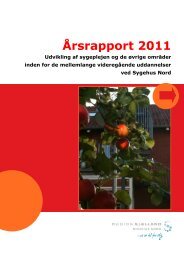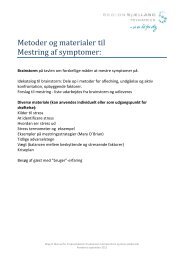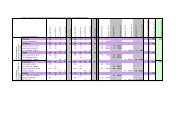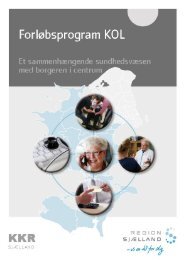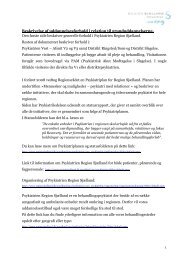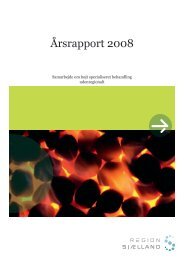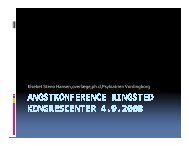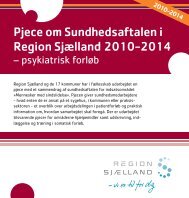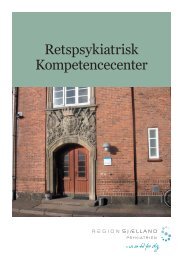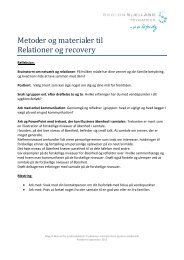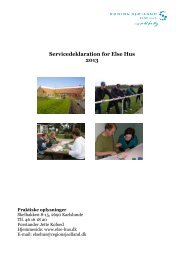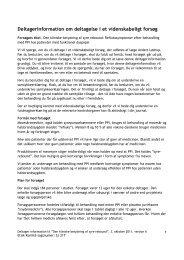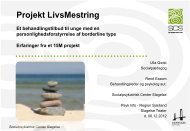Årsrapport 2011 - Region Sjælland
Årsrapport 2011 - Region Sjælland
Årsrapport 2011 - Region Sjælland
Create successful ePaper yourself
Turn your PDF publications into a flip-book with our unique Google optimized e-Paper software.
KMA_0811<br />
Application of DNA sequence analysis of 16S-23S Intergenic Spacer (ITS) region for<br />
species identification of strains belonging to the genera Abiotrophia, Aerococcus,<br />
Alloiococcus, Dolocicoccus, Dolosigranulum, Facklamia, Gemella, Globicatella,<br />
Granulicatella, Ignavigranum, Leuconostoc, and Rothia.<br />
X. C. Nielsen 1 , R. Dargis 2 , M. Hammer 2 , A. Hesselbjerg 2 , L. Hannecke 1 , U. S. Justesen 3 , M. Kemp 3 , J. J. Christensen 1<br />
Department of Clinical Microbiology, Slagelse Hospital, Slagelse 1 ; Department of Microbiological Surveillance and Research, Statens Serum Institut,<br />
Copenhagen 2 ; Department of Clinical Microbiology, Odense University Hosptial, Odense 3 , Denmark.<br />
Introduction and Purpose<br />
The 16S-23S Intergenic Spacer (ITS) region has been found<br />
useful in separating most of the clinically relevant nonhaemolytic<br />
streptococci (NHS)1. The group of catalasenegative<br />
gram-positive cocci not belonging to the<br />
Streptococcus genus cause endocarditis and can easily be<br />
misidentified with conventional methods as well2. In this<br />
study we have included 40 species belonging to the genera of<br />
Abiotrophia (1), Aerococcus (7), Alloiococcus (1), Dolocicoccus<br />
(1), Dolosigranulum (1), Facklamia (6), Gemella (7), Globicatella<br />
(2), Granulicatella (3), Ignavigranum (1), Leuconostoc (4), and<br />
Rothia (6). The purpose was to investigate the possibility of<br />
using the ITS sequence analysis for species identification of<br />
the strains belonging to these genera.<br />
Methods<br />
39 type strains were purchased from CCUG.<br />
Six pairs of primers were designed based on the available<br />
16S and 23S sequences from the included species from<br />
GenBank.<br />
Optimization of PCR conditions for the six primer pairs.<br />
ITS PCR performed on all 39 strains with the optimal primer<br />
pair.<br />
PCR product analysis using 2% agarose gel electrophoresis<br />
and automatic capillary electrophoresis system Qiaxcel<br />
(Qiagen)<br />
Sequencing of the PCR products using ABI Prism 3100<br />
Avant genetic analyzer (Applied Biosystems, USA).<br />
Sequence editing and analysis using CLC-DNA workbench<br />
(Aarhus, Denmark) and MultAlin (http://multalin.toulouse.<br />
inra.fr/multalin/)<br />
A. M 1 2 3 4 5 6 7 8 9<br />
B. M 1 2 3 4 5 6 7 8 9<br />
108 ÅRSRAPPORT <strong>2011</strong><br />
Results<br />
1. The primer pair with the best PCR result is:<br />
6R-IGS 5’-GGG TTC CCC CAT TCG GAH AT- 3’<br />
Strep16S_1471F 5’-GTG GGA TAG ATG ATT GGG GTG AAG T-3’<br />
2. PCR from all strains generated one<br />
major product (Figure 1.)<br />
3. ITS sequences were generated for 33 out of 40 strains<br />
(Table 1). Sizes of the edited ITS sequences ranged from<br />
195- 384 bp. The two species belonging to Globicatella did<br />
not generate a reasonable sequence.<br />
4. Alignment of the ITS sequences showed that there was<br />
great interspecies variation among the different species,<br />
including those belonging to the same genus (>5%).<br />
Conclusions<br />
ITS gene sequence analysis seems to be a good candidate<br />
for species identification of strains belonging to the genera<br />
Abiotrophia, Aerococcus, Alloiococcus, Dolocicoccus,<br />
Dolosigranulum, Facklamia, Gemella, Granulicatella,<br />
Ignavigranum, Leuconostoc, and Rothia. Also, the potential<br />
usefulness of ITS for identification for Globicatella has to be<br />
explored further as, if possible, ITS can be used as the initial<br />
step in identifying this large group of genera, including NHS.<br />
References<br />
Nielsen, X.C., U. S. Justesen, R. Dargis, M. Kemp, and J. J. Chrsitensen. 2009. J. Clin. Microbiol. 47: 932-939<br />
Brouqui, P., and D. Raoult. 2001. Clin. Microbiology. Rev. 14:177-207<br />
Results Table 1. ITS sequencing results.<br />
Figure 1. Detection of PCR<br />
products after ITS PCR.<br />
A. 2% agarose gel<br />
B. Qiaxcel<br />
M. DNA ladder<br />
1. Abiotrophia defectiva<br />
2. Aerococcus christensenii<br />
3. Aerococcus sanuinicola<br />
4. Aerococcus suis<br />
5. Aerococcus urinae<br />
6. Aerococcus urinaeequi<br />
7. Aerococcus urinaehomonis<br />
8. Aerococcus viridans<br />
9. Alloiococcus otitis<br />
Correspondence author: Xiaohui Chen Nielsen, Department of Clinical Microbiology, Slagelse Hospital,<br />
<strong>Region</strong> Zealand, Denmark. Phone: 0045 5855 9404. E-mail: xcn@regionsjaelland.dk<br />
Genus<br />
Included species Species achieved ITS<br />
(n)<br />
sequence (n)<br />
ITS size (bp)<br />
Species achieved ITS sequence<br />
(taxon)<br />
Species NOT achieved ITS<br />
sequence (taxon)<br />
Abiotrophia 1 1 242 A. defectiva<br />
A. christensenii, A. sanguinicola, A.<br />
Aerococcus 7 7 218-242 suis, A.urinae, A. urinaehominis, A.<br />
viridans<br />
Alloiococcus 1 1 238 A. otitis<br />
Dolosicoccus 1 1 264 D. paucivorans<br />
Dolosigranulum 1 1 249 D. pigrum<br />
Facklamia 6 4 226-280<br />
F. hominis, F. languida, F.<br />
miroungae, F. sourekii<br />
F. ignava, F. tabacinasalis<br />
G. bergeri, G. cuniculi, G.<br />
Gemella 7 6 195-217 morbillorum, G. palaticanis, G.<br />
sanguinis<br />
G. asaccharolytica,<br />
Granulicatella 3 3 209-228<br />
G. elegans, G. balaenopterae,G.<br />
adiascens<br />
Globicatella 2 0 G. sanguinis, G. sulfidificiens<br />
Ignavigranum 1 1 208 I. ruoffiae<br />
Leuconostoc 4 3 382<br />
Rothia 6 5 317-384<br />
L. mensenteroides (subspp.<br />
Mesenteroides, cremoris,<br />
dextranicum)<br />
R. amarae, R. dentocariosa, R.<br />
mucilaginosa, R. terrae, R.<br />
nasimurium<br />
L. lactis<br />
R. aeria



